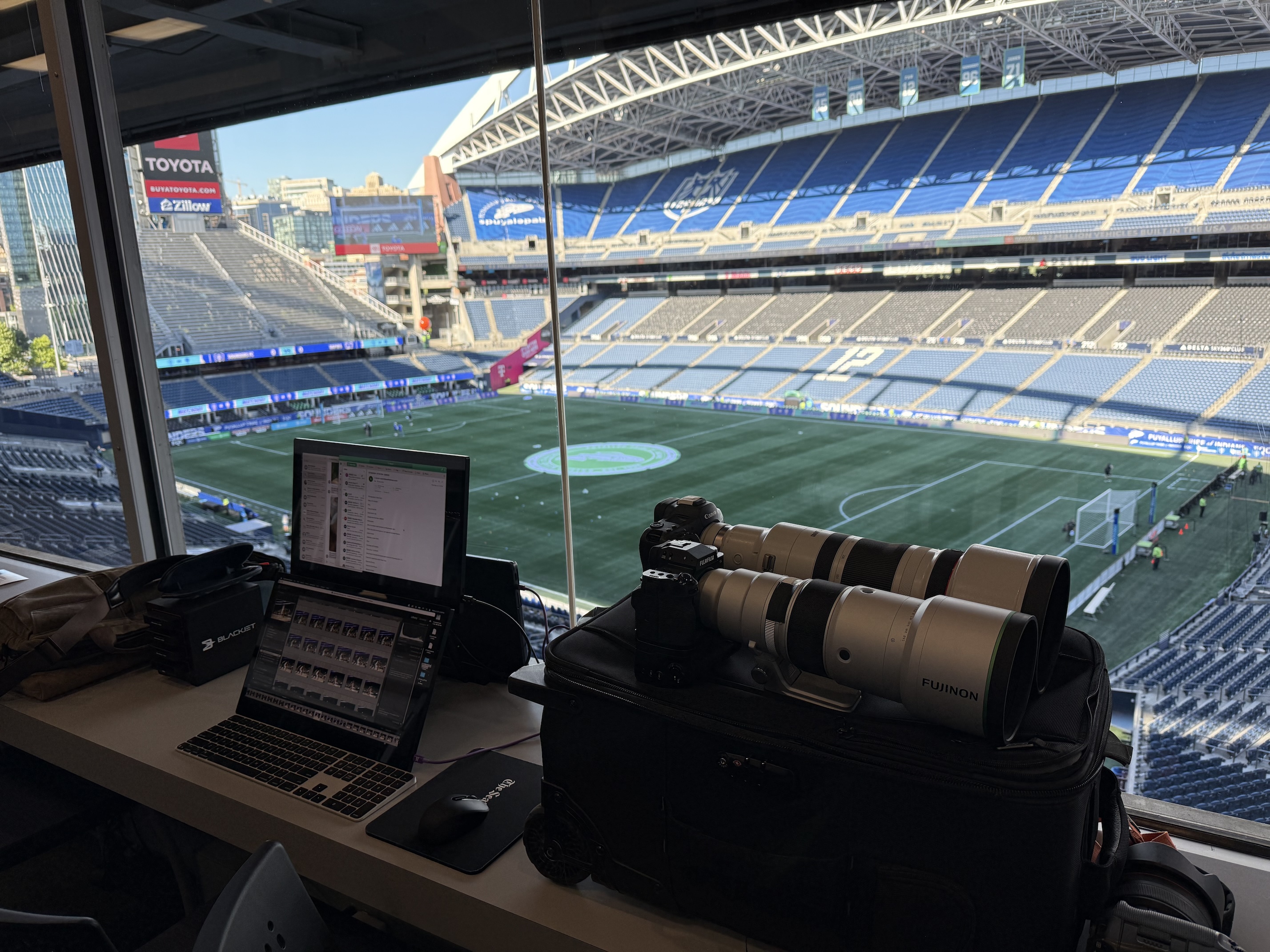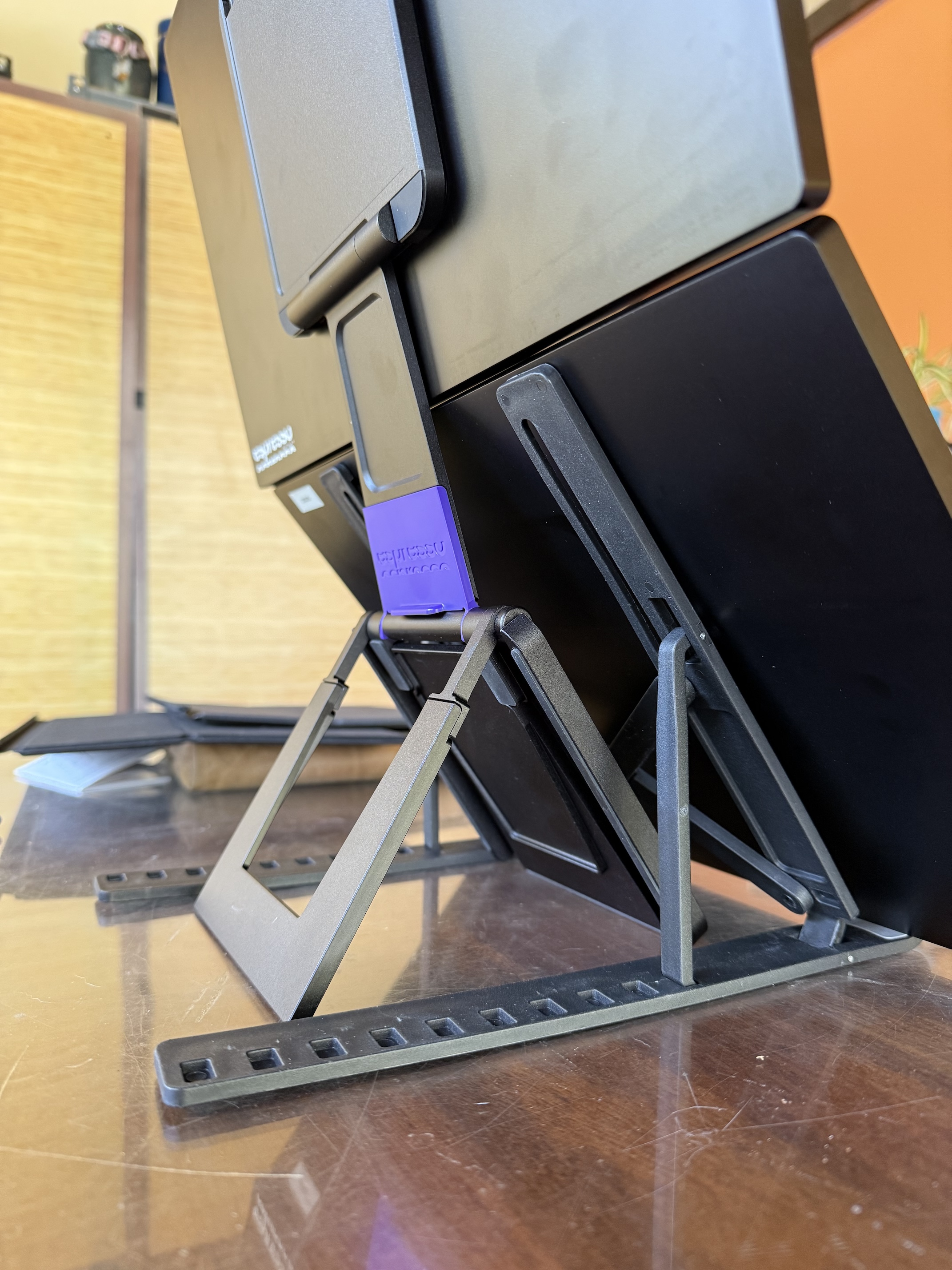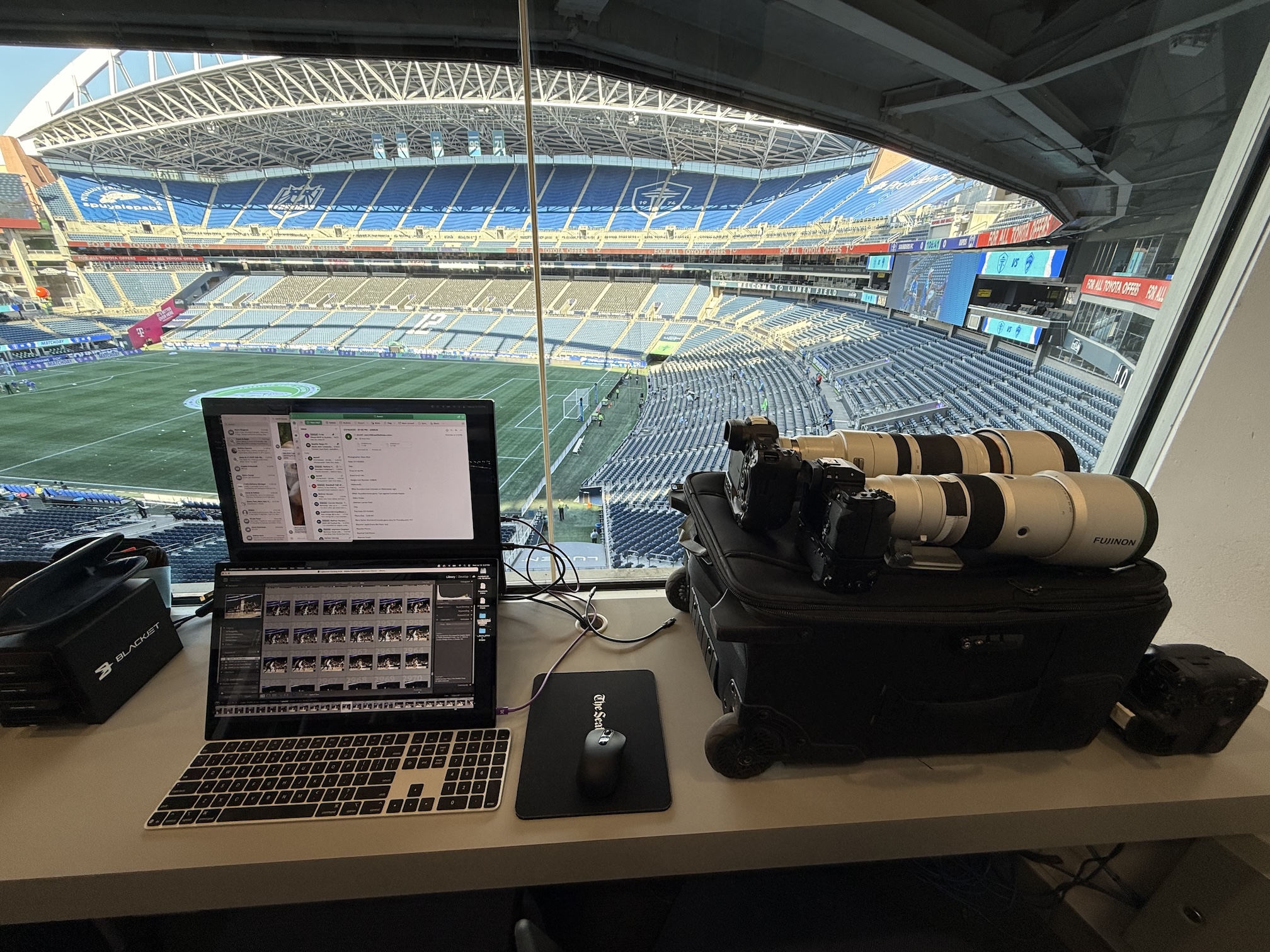Dean Rutz is photojournalist and senior staff photographer at The Seattle Times, one of the largest family-owned independent newspapers in the United States. With more than 50 years working in professional photography, and 37 years at the Times, Rutz has literally seen (and captured) it all from behind a lens.
From the early days of his career, long before digital imaging, Dean and his colleagues were meeting production deadlines with an intensity and attention to detail that would rival the athletes he captures on film.
“We would get a little four-seat Cessna and fly from West Palm Beach up to Gainesville to the University of Florida, shoot a game, and we would have a darkroom tech with us who had done the math as to how quickly an igloo cooler would lose degrees per hour… we would use a dark bag, load up all the film into the dark bag, and then process film at 10,000 feet in an igloo cooler.”
From working with teams developing film at 10,000 feet in a rented plane, Dean also transformed hotel bathrooms in darkrooms, stating:
“Back when I got started in picture editing at the Seattle Times 1988, we still were not in a digital era. We were just starting to get into the digital era. So a lot of my job was building dark rooms on site.
So for example, if you go back to the 1991 Rose Bowl, I'm famous for doing 110 rolls of colour negative film in the bathtub of the Hilton Hotel in Pasadena. I set up an AC41 line in the bathtub, (which) kind of destroyed the tub too. But that's because I've got four guys working in the Rose Bowl, the football championship game. They're shipping the film back to the hotel. I've got to process, I've got to edit. I've got to move stuff very quickly back home.”
Rolls of Film to 5,000 Frames Per Game: The Modern Volume Challenge
In 1991, Dean was processing 110 rolls of color negative film in the bathtub of a Pasadena Hilton. In more recent years he's managing 5,000+ digital frames per baseball game. The challenge in 2025 is about less physical logistics, and more about workflow management with the advanced tools we have.
"Major League Baseball is about four to 5000 frames (per game), because you're going on every pitch, you just don't know when that guy's going to hit a home run or a strikeout or whatever," explains Rutz. "The issue becomes how do I sort that out on deadline?"
The math/s is brutal. The game starts at 7 PM. Deadline is 9 PM. The Seattle Times dedicates four to five broadsheet pages to NFL coverage, requiring multiple high-quality images processed, cropped, toned, and captioned, all while monitoring the ongoing game and communicating with editors.
Dean’s process to manage this level of production is a blueprint for any professional working under extreme deadline pressure.
In addition to production output, workspace and location also comes into the equation.

The Space Problem: Going Up, Not Out
Press boxes at stadiums weren't designed for workflow. When it comes to creating a multi-display setup to manage content Dean has had to innovate, "I can go up as high as I want, but I can't go out because I'm in a press box and I'm shoulder to shoulder," he explains. "So if I put two 17-inch displays side by side, I'm encroaching on somebody else's space. So I've always liked to kind of put things on top of each other."
This spatial constraint led to his signature dual-display vertical setup. Bottom display: pure image processing. Top display: FTP monitoring, desk communications, and play-by-play for caption writing.
This workflow eliminates what Dean calls one of the biggest efficiency killers in sports photography: toggling between tasks. "I don't have to flip back and forth, particularly with captioning. It's the biggest thing of all, as you're processing that image, you want to write a caption to have the play by play on another screen above you that you can see OK. This was a 32 yard pass down to the 20 yard line at 4:25 in the third quarter. I can read that and type that. I don't have to toggle back and forth or copy and paste."
The Decision-Making Process: One in 5,000 shot
How do you pick the right shot from 5,000 frames in minutes? Experience and smart decision making based on the gameplay.
"The advantage of having done this for so long is that I understand the game. So as the game is in progress, I kind of know what's significant. Plus, I keep that monitor open. So I'm talking to the reporter in the press box. I know what they're writing about."
Dean doesn't process chronologically. He jumps directly to significant moments. "If you know if you score, you know, a touchdown in the first quarter, I'll ignore those first 1000 frames and get right to that touchdown. Look at that sequence on my screen, 2030 frames in the sequence, pull the one that's correct or the one that I like, caption it, and get it out."
This is where screen real estate becomes crucial: "You want to look at the sequencing because you're never going to shoot just one frame. How did that whole play evolve? What looks good, what crops well and makes sense."

How espresso Displays Fit the Workflow
Camera, lens, and display quality isn't negotiable for Dean. "The colour, quality and fidelity is fantastic. I know that when I'm processing with my espresso, the colours are correct, I can tell the sharpness in the crop very well. I know exactly what I'm doing and the product that I'm going to get in print."
The 17-inch displays hit the sweet spot for his needs: large enough for detailed image work, compact enough for travel, and stackable for his vertical workflow. He's running two 17-inch espresso displays with a 14-inch MacBook Pro, creating what he calls his "road kit."
Aside from a good workflow, setup, packing for travel is critical. Rutz carries his setup in Think Tank camera cases with custom Waterfield bags (sfbags.com) that protect the displays while fitting airline overhead compartments.

Advice for Emerging Professionals
While tech continues to change and enhance how we work, Dean’s approach typifies what innovation looks like, regardless of the tech at hand. It’s a commitment to overlooking barriers getting it done, no matter what.
Talking about the current state of play for aspiring sports photographers, it’s perhaps a tougher landscape to break into. "It's getting harder and harder because of the contraction within the media industry. It's getting harder to find these types of jobs," Rutz acknowledges.
His advice for newcomers is practical: start with athletics organizations. "Major League Baseball National Football League, even the NBA, are hiring tonnes of young shooters to do social for them, even the athletes themselves are beginning to hire social media people."
But equipment costs remain a barrier. "If you're looking at a Canon 400mm f2.8 lens eight, you're looking at eleven $12,000. You can't justify that when they're trying to pay you $200.00 a day." Before moving up the payscale of products, Dean recommends exploring alternatives like Fujifilm, which offers somewhat comparable performance at roughly 60% of the pricing.
Technology as the Great Equalizer
What excites Dean most about current technology trends? Miniaturization and connectivity.
"Miniaturisation largely and it's a lot of what I've seen with Fuji being that's a crop sensor camera they can build smaller and lighter, than even Canon. The Canon isn't building smaller, but they've cut the weight of the average lens in half."
Cloud connectivity is also changing the competitive landscape.
Modern cameras can upload directly to servers, with phones serving as intermediate editing stations. "How do you, as one guy, compete against an international news agency? Well, if the technology comes to you suddenly, the bigger player loses its advantage."
The Future of Professional Photography (and workflows)
The fundamental shift is clear: technical skill isn't enough anymore.
"Anybody can hit the auto level on Photoshop and have a good looking image. So what distinguishes your skill set now? It's going to be how well you use the technology to deliver, to have deliverables in the marketplace as fast as anyone else."
This philosophy drives Dean’s continuous experimentation with tools like espresso Displays. But it's not about having the latest gear, it's about creating professional advantages and taking the right steps to recognize how technology can optimize efficiency.
“Speed and efficiency are key to competitiveness.”

Setup Specifications: Dean's travel kit
Every component serves a specific purpose to reduce friction and maximise output.
- 14-inch MacBook Pro (M4 Pro chip) or Mac Mini M4 Max for more ports
- Two 17-inch espresso Pro 17 displays in vertical stack configuration
- Custom Waterfield cases for display protection
- Think Tank camera cases for integrated transport
- Multiple card readers (requires Mac Mini for sufficient ports)
You can check out more of Dean's work at the Seattle Times website: https://www.seattletimes.com/author/dean-rutz/




.png)
.png)
